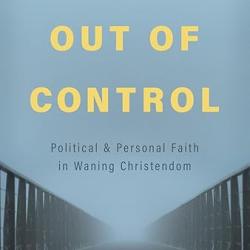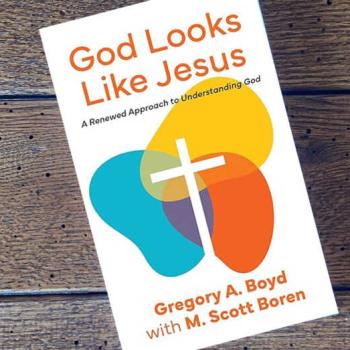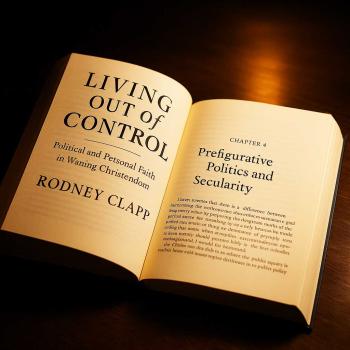Review of The Journey of Modern Theology by Roger E. Olson by Bev Mitchell
This book is written to grab you (gently) and introduce you to some of the most interesting people of the last four hundred years. Yes, most of them were philosophers and theologians, but they were people first and always people. Roger Olson knows these people, some personally, but mainly through careful, sympathetic reading of much of their work over a long career. The characters march across the pages almost as if the author is presenting his friends to us. He knows them well, and wants us to know them – not to always agree with them for that would be impossible, but to know them as people who had great ideas, to know what the heart of those ideas was and to know why these particular people had these particular ideas. And to know the human and intellectual context into which these ideas spoke.
In his two page note of required reading at the beginning, Dr. Olson says “This book’s primary intended audience is not scholars of modern theology but students, pastors and interested laypeople……. The goal…. is to inform readers about the lives, careers, major ideas, legacies and possible problems of these thinkers.” This lay person and lifelong student thinks that this mission has been admirably accomplished. All students of theology who love people and their ideas will get much from this volume.
They were all chosen for inclusion in this book because they made very significant contributions to Christian theology. Like today, they all worked in a time when how we ask and attempt to answer questions, and even the questions we think we should be asking, was in great ferment. In the century before the first and second world wars, many wanted, and thought they could find, sure answers to all questions. Others were concerned that we should not be so bold as to ask certain questions. Others thought the questions and answers already available should do well enough. Still others were not so sure about certainty and struck out like bold explorers who saw a need to know what lay over that hill or beyond that ocean. Some paid dearly for their audacity, all are heroes to someone. All were very human. Their journeys, taken as a whole, as a package, have much to say about where were are now as Christians trying to understand who we are, who God is and how we should relate to him and to each other.
By the thirties and certainly by the forties, it was clear that some of the theological certainties were nothing more than illusions. Many of the hopes for human improvement were dashed. There had already been warnings from some that humans are not really the masters of their fate but now those voices, mostly long ignored, were being heard again. A strength of Olson’s treatment is how clearly he ties together voices across the great divide created by the two world wars. Thinkers like Kierkegaard, Coleridge, Bushnell, Barth, Niebuhr and Moltmann are linked together across the centuries. All this without leaving out or minimizing other threads from thinkers like Schleiermacher, Troeltsch, Bultmann, Tillich, and Whitehead. The contrasts across these lines of thought are made clear, but Olson does not miss many opportunities to show how important cross currents flowed for those with the good will to see.
The giants and many of the lesser knowns walk these pages. Importantly, the lesser knowns come off as significant contributors to a fascinating journey. They are simply lesser known, not necessarily lesser in any other way. Several of these ‘lesser’ lights were mediators. We are also given glimpses of how this sidelining of certain voices can happen. It’s not always a political or academic power process either. There are often fascinating personal and cultural dynamics at work in determining who gets remembered well. One of the mediators that I would highlight is I.A. Dorner because Olson’s presentation of him is a particularly good example of how lesser knowns are honoured in this book. Olson’s presentation of such people is a great strength. Their work not only clarifies the extremes, often represented by the big names, but also shows how much of the very good there is in the extremes, especially when moderated and modulated by rather different views.
In case you think that such a volume must of necessity deal with cut and dried dogmatic statements, systematized thinking that will leave you feeling completely satisfied that the intellect stands supreme, there is romanticism here too. Søren KIerkgaard makes several appearances because he influenced many, and Samuel Taylor Coleridge appears alone and in company with Horace Bushnell. Imagination shines forth not as the devil’s playground but, to borrow from Bushnell, as a “transcendently perceptive, creative, unifying power.” This aspect of theology is well represented throughout these pages.
On the science/faith front, we are shown how some theologians were prepared to let science drive the show, others wanted to build an impermeable barrier between the two while yet others at least envisioned the possibility of building something together that gets closer to the truth than either can alone. Philosophy is not ignored, rather philosophers are revealed as essential to the work of theologians, even for those theologians who wanted to avoid philosophy. The high drama between those, philosophers and theologians, who want to have answers to everything, even speculation anointed as fact, and those more comfortable with mystery, or just not knowing for now, is palpable.
There are liberals, conservatives, progressives and the unclassifiable here. If you read carefully, you may well come away with a much more nuanced appreciation of these often flammable designations. You may even be able to make a case for not paying too much attention to such labelling. There are really very few dividing lines, lines in the sand, when the views of these men (remember the time, they are unfortunately all men) are fully and fairly considered. Leanings, biases, blind spots, egos yes, but clear boundaries are not always so clear, or certainly permeable enough to allow valuable cross fertilization.
Often we are treated to biographical detail, not for its own sake, but integrated into the subject’s concerns, angst, faith and conflicts in such a way that we come to understand the theology or philosophy much better. These are all presented as real people. Great thinkers, yes, but people whose thoughts are not divorced from their life, culture or context. This is a history of real people who had great ideas. Sometimes they worked in an environment congenial to their thoughts, perhaps more often something of the hero was required in them to challenge what they believed to be error or mis-direction. Some were excommunicated, some were ostracized. It’s all here and it all belongs together to tell a great story.
The book is well organized so that it can be easily used as a reference. The sections on major theologians are easily found, and they tend to be grouped in a functional manner. The material on each major figure is also systematically organized making it easy to locate, for example, biography, summary, relation to science and relation to modernity. Sub-headings are provided for each one as well highlighting larger themes in their theology. These will become even more useful as the reader becomes familiar with Olson’s organizational style. All of these features will greatly facilitate comparative study.
A thematic thread runs through the work regarding science and faith. Olson frames it in the hypothesis that “much of modern theology is consciously or unconsciously constructed to avoid conflicts between science and Christianity”. The investigation of this hypothesis does not take up large parts of the text, but each major theologian is asked (via their written work) if this hypothesis makes sense, It’s beyond the scope of this review to summarize the results that Olson assembles, but it would be a good exercise to do so.
Because of the nature of this book, a survey with a bird’s eye view of a significant period of history, we will all miss a favourite or two in its pages. For me, though both are appropriately mentioned, not finding more on T.F. Torrance or C.S. Lewis was a disappointment. Olson covers this kind of unavoidable complaint early on with a quip regarding birds’ eye views “Not every bird’s, of course, but this bird’s.” This reminds me to briefly mention humour and its subtle possibilities. Overt humour is difficult to find in this volume, but there is a lightness, not at all quip-like or tongue-in-cheek, but a kind of joy present throughout. I think Dr. Olson had a lot of fun writing these pages. They represent the distillation of many years work and thinking, they include the sad loss of a friend and colleague who co-authored a previous volume of which this is more than a complete revision, but they show forth an author at the top of his game revelling in his subject.












